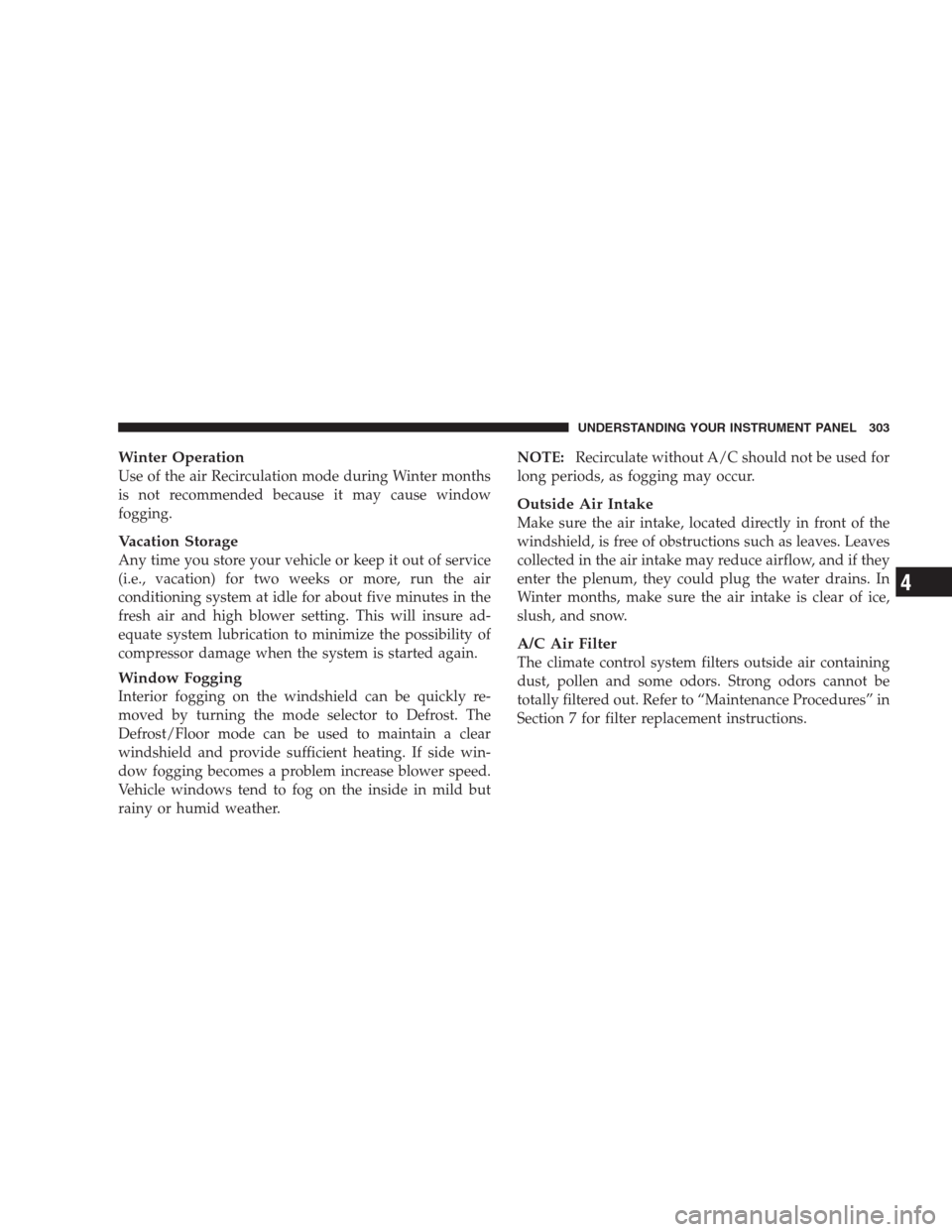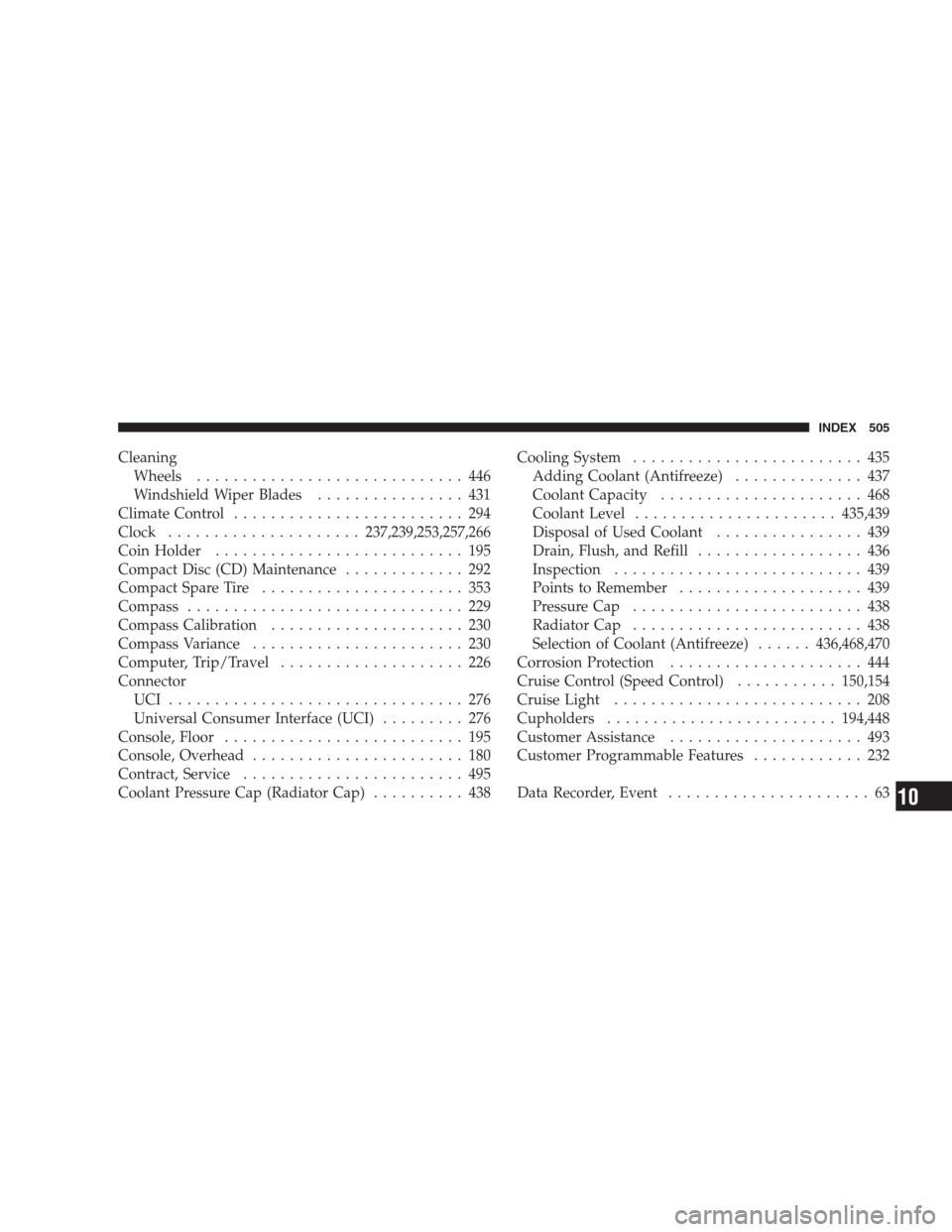Page 305 of 526

Winter Operation
Use of the air Recirculation mode during Winter months
is not recommended because it may cause window
fogging.
Vacation Storage
Any time you store your vehicle or keep it out of service
(i.e., vacation) for two weeks or more, run the air
conditioning system at idle for about five minutes in the
fresh air and high blower setting. This will insure ad-
equate system lubrication to minimize the possibility of
compressor damage when the system is started again.
Window Fogging
Interior fogging on the windshield can be quickly re-
moved by turning the mode selector to Defrost. The
Defrost/Floor mode can be used to maintain a clear
windshield and provide sufficient heating. If side win-
dow fogging becomes a problem increase blower speed.
Vehicle windows tend to fog on the inside in mild but
rainy or humid weather.NOTE:Recirculate without A/C should not be used for
long periods, as fogging may occur.
Outside Air Intake
Make sure the air intake, located directly in front of the
windshield, is free of obstructions such as leaves. Leaves
collected in the air intake may reduce airflow, and if they
enter the plenum, they could plug the water drains. In
Winter months, make sure the air intake is clear of ice,
slush, and snow.
A/C Air Filter
The climate control system filters outside air containing
dust, pollen and some odors. Strong odors cannot be
totally filtered out. Refer to “Maintenance Procedures” in
Section 7 for filter replacement instructions.
UNDERSTANDING YOUR INSTRUMENT PANEL 303
4
Page 501 of 526

Treadwear
The Treadwear grade is a comparative rating, based on
the wear rate of the tire when tested under controlled
conditions on a specified government test course. For
example, a tire graded 150 would wear one and one-half
times as well on the government course as a tire graded
100. The relative performance of tires depends upon the
actual conditions of their use, however, and may depart
significantly from the norm due to variations in driving
habits, service practices, and differences in road charac-
teristics and climate.
Traction Grades
The Traction grades, from highest to lowest, are AA, A, B,
and C. These grades represent the tire’s ability to stop on
wet pavement, as measured under controlled conditions
on specified government test surfaces of asphalt and
concrete. A tire marked C may have poor traction perfor-
mance.
WARNING!
The traction grade assigned to this tire is based on
straight-ahead braking traction tests, and does not
include acceleration, cornering, hydroplaning, or
peak traction characteristics.
Temperature Grades
The temperature grades are A (the highest), B, and C,
representing the tire’s resistance to the generation of heat
and its ability to dissipate heat, when tested under
controlled conditions on a specified indoor laboratory
test wheel. Sustained high temperature can cause the
material of the tire to degenerate and reduce tire life, and
excessive temperature can lead to sudden tire failure. The
grade C corresponds to a level of performance, which all
passenger car tires must meet under the Federal Motor
Vehicle Safety Standard No. 109. Grades B and A repre-
sent higher levels of performance on the laboratory test
wheel, than the minimum required by law.
IF YOU NEED CONSUMER ASSISTANCE 499
9
Page 507 of 526

Cleaning
Wheels............................. 446
Windshield Wiper Blades................ 431
Climate Control......................... 294
Clock.....................237,239,253,257,266
Coin Holder........................... 195
Compact Disc (CD) Maintenance............. 292
Compact Spare Tire...................... 353
Compass.............................. 229
Compass Calibration..................... 230
Compass Variance....................... 230
Computer, Trip/Travel.................... 226
Connector
UCI ................................ 276
Universal Consumer Interface (UCI)......... 276
Console, Floor.......................... 195
Console, Overhead....................... 180
Contract, Service........................ 495
Coolant Pressure Cap (Radiator Cap).......... 438Cooling System......................... 435
Adding Coolant (Antifreeze).............. 437
Coolant Capacity...................... 468
Coolant Level......................435,439
Disposal of Used Coolant................ 439
Drain, Flush, and Refill.................. 436
Inspection........................... 439
Points to Remember.................... 439
Pressure Cap......................... 438
Radiator Cap......................... 438
Selection of Coolant (Antifreeze)......436,468,470
Corrosion Protection..................... 444
Cruise Control (Speed Control)...........150,154
Cruise Light........................... 208
Cupholders.........................194,448
Customer Assistance..................... 493
Customer Programmable Features............ 232
Data Recorder, Event...................... 63
INDEX 505
10